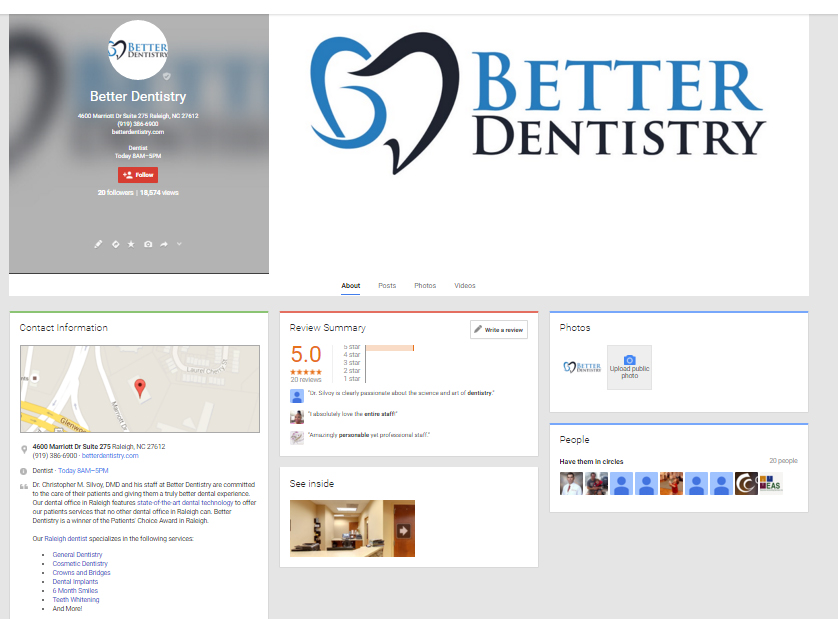6 SEO Strategies for Your Dental Practice
1. Keyword Research
Research and analysis are major components to a successful SEO strategy. When conducting keyword research, it is important to include landscape, your competition, and most importantly, relevant keywords. There are a variety of free keyword research tools that can help you find new, relevant search terms. Here are a few of our favorites: The key to keyword research is not using the most competitive keywords out there. Instead, select those that you can dominate, and, in turn, will will bring you the most traffic. The best keywords to target are those that are hyper-targeting. For example, instead of targeting “Raleigh Dentist,” target ” Pediatric Dentist in Raleigh NC” or “Urgent Care Dentist Raleigh NC.” This will help to draw in new patients that are looking for specific services in your area– now.2. Create Service Targeted Content
When using a search engine, like Google, it is important to understand that Google does not rank your website as a whole entity but, instead, as individual pages. For example, if I am Googling “teeth whitening dentist in Raleigh,” the top ranked search results are going to be pages about teeth whitening services or cosmetic dentistry, not the homepage of your site (unless it has been optimized for teeth whitening.) When creating content for your website, you want original content that goes in depth about the topic or service you are offering. In other words, instead of just filling space and meeting a 2,500 word minimum, prove that you are an expert on the subject. If you are offering teeth whitening services, consider creating a page that answers your client’s questions: Is whitening a good option for me? What are the pros/cons? Will it hurt? Can it damage my teeth? How long will it take? How Does it work? What is the procedure? What chemicals are used? Will my teeth be sensitive after? etc. Consider the questions that your patients ask you as a starting point. Then, use your expert knowledge on the subject to elaborate, creating quality content.3. On-Page Optimization: Title Tags
 There are many elements to an optimized page. This is everything from being viewable on multiple devices, including popular browsers and optimized to render legibly and aesthetically on all screen sizes, to being keyword targeted and crawler/bot accessible. While these can be time consuming and sometimes tedious tasks, it offers a great reward.
When optimizing your pages, make sure that you have a Title Tag. This text describes the page and shows up in 3 different places:
There are many elements to an optimized page. This is everything from being viewable on multiple devices, including popular browsers and optimized to render legibly and aesthetically on all screen sizes, to being keyword targeted and crawler/bot accessible. While these can be time consuming and sometimes tedious tasks, it offers a great reward.
When optimizing your pages, make sure that you have a Title Tag. This text describes the page and shows up in 3 different places:
- In the tabs of your browser.
- On external websites, mainly on social media sites.
- On the results page of a search engine.
- Put the main keywords at the beginning of your Title Tag.
- Consider your brand. If your dental practice is large enough, you may want to put your brand name at the beginning of the Title Tag. Or, if you are a smaller practice, do not include your practice’s name in the Title Tage or leave it towards the end.
- Keep user experience in mind. Remember that this may be the first interaction a potential patient has with your practice; make your Title Tag compelling to encourage the viewer to visit your site.
- Keep your Title Tag between 50-60 characters (512 pixels).
 In both examples, A and B, the main keywords are located in the beginning of the Title Tag. The Title Tag in example A reads, “Family & Cosmetic Dentistry | Cary NC Dental Office,” focusing on Family Dentistry and Cosmetic Dentistry. Similarly, example B focuses on Sedation Dental Care and Cosmetic Dentistry. Conveniently, both of these practices use their keywords in their brand names so their brand name is also included at the beginning of their Title Tag.
A main difference between the examples is the length of the Title Tag. Example A uses a title tag that is within 512 pixels, while example B exceeds the width limit. You can see that the Title Tag in example B is cut off at the end and an ellipses is added.
In both examples, A and B, the main keywords are located in the beginning of the Title Tag. The Title Tag in example A reads, “Family & Cosmetic Dentistry | Cary NC Dental Office,” focusing on Family Dentistry and Cosmetic Dentistry. Similarly, example B focuses on Sedation Dental Care and Cosmetic Dentistry. Conveniently, both of these practices use their keywords in their brand names so their brand name is also included at the beginning of their Title Tag.
A main difference between the examples is the length of the Title Tag. Example A uses a title tag that is within 512 pixels, while example B exceeds the width limit. You can see that the Title Tag in example B is cut off at the end and an ellipses is added.
4. Internal & External Linking
As you create content pages on your website, you will likely reference things that you have already discussed on another page. Or, if you have not yet created content on that subject, you may want to supply your readers with a link to an expert source. Offering expert sources and supplemental information shows that you are aware of the authorities in your field. In these situations, you can use anchor text and create a link to anoother page. This allows you to pass “link juice” across your pages.5. Link Building
You can increase your Google ranking by getting links to your website from external sources. There are many ways to get links back to your site from the web. A few link building strategies include press releases, blog commenting on industry-related articles, and creating citations on local and dental specific directories. According to Moz, here are the top citations for dental practices:- Yelp.com
- Yellowpages.com
- YouTube.com
- Healthgrades.com
- Superpages.com
- DexKnows.com
- Doctoroogle.com
- Local.Yahoo.com
- Facebook.com
- AngiesList.com
6. Create a Google+ Profile
Creating social media profiles for your business is important. One of the top social media channels you should take advantage of is Google+. Google+ is not only a social media platform, but also a tool that can be used to help improve organic search results and local search listings. According to Adobe, as the 3rd largest social media networking site, trailing behind Facebook & Twitter, the most obvious reason to use Google+ is because Google owns it. Your profile should include your logo, photos of your staff and practice, a in-depth description that includes links back to your site, hours of operation, your address (the same way it is written on your website, for consistency), and phone number Once your profile is complete, you will need to verify your business (may take 3-5 days). Here is an example of a complete and SEO-optimized Google+ page:
Need help implementing SEO strategies for your dental practice? Let our SEO team increase your organic search rankings and grow your dental practice. Get started by calling 919-341-8901 or scheduling your free consultation today.






